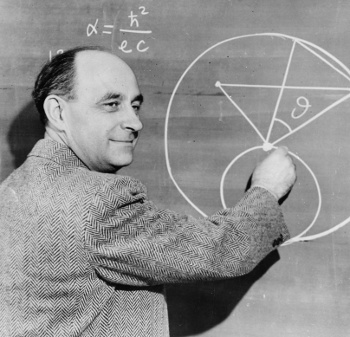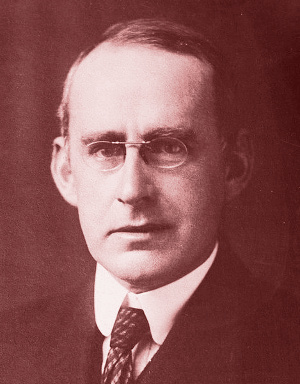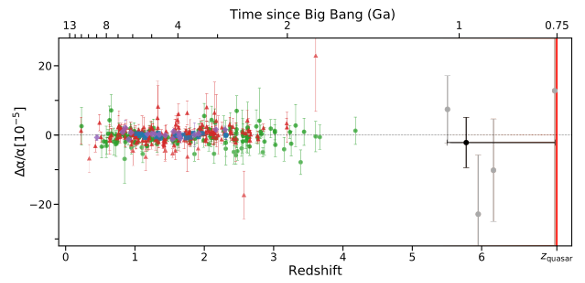The Fine Structure Constant
June 8, 2020
Memes have existed for a long time prior to the
Internet. One of these
ancient memes is
alpha and omega, in which
alpha (α), the first letter of the
Greek alphabet, and
omega (ω), the last letter of the Greek alphabet, are combined the indicate an entirety of things from the first to the last. The alpha and omega was identified as a
Christian symbol in the
Bible.
Alpha has been used as the name for two fundamental things in
physics. The
alpha particle, which is a bare
helium nucleus emitted during
radioactive decay in which an
element transforms into another element by shedding nuclear matter. The
fine structure constant, also symbolized by alpha, is a
dimensionless physical constant that specifies the strength of the
interaction of
charged particles. Why alpha has its particular value, and not some other, is one of the
mysteries of physics.

Nobel Physics Laureate, Enrico Fermi (1901-1954), at a blackboard after writing the wrong expression for the fine structure constant, alpha.
Fermi's smile might indicate that this was a joke, or a test question for his audience.
(Image from the Smithsonian Institution, via Wikimedia Commons)
The fine structure constant agrees with
theory to eleven
decimal places. The fine structure constant is related to some rather fundamental things; namely, the
elementary charge e,
Planck's constant h, the
speed of light c and the mathematical constant
π,
α = (2 π e2)/(h c)
So, asking why
α has its particular value is the same as asking why these other physical constants have their particular values.
What's just as mysterious is that the
reciprocal of
α is a small number quite close to 137. Its
CODATA 2014 value is 137.035 999 139,[1] but it was indistinguishable from the exact value of 136 early in the
20th century. As I wrote in an
earlier article (Numerology, March 2, 2015),
physicist,
Arthur Eddington (1882-1944), who rose to fame by his
observational verification of
Einstein's theory of general relativity by observing the
bending of starlight around the
Sun during
solar eclipse of May 29, 1919, proposed an
a priori reason why it should be
exactly 136.
The number of
protons in the
universe, now called the
Eddington number, is estimated to be about 10
80, and Eddington
conjectured that this number was actually 136 x 2
256; or. later, 137 x 2
256. Using 137 and a little
calculation allowed Eddington to make the statement in 1939 that "...there are 15 747 724 136 275 002 577 605 653 961 181 555 468 044 717 914 527 116 709 366 231 425 076 185 631 031 296 protons in the universe and the same number of electrons."

Physicist, Sir Arthur Stanley Eddington (1882-1944).
Astrometry was primitive in 1919, so Eddington's evidence in confirmation of relativity was tenuous, but sufficient to convince physicists of his era. A 1979 computer-assisted re-analysis of his original eclipse plates confirmed his conclusions.[2]
(United States Library of Congress, Prints and Photographs Division, image ggbain.38064, via Wikimedia Commons, modified for artistic effect.)
Most physicists rejected this strange
numerological and
teleological approach to physics that was more like the
Philosophy of
Aristotle (384-322 BC) and less like the observational approach of
Galileo (1564-1642). A
parody of this approach was
published by
Guido Beck,
Hans Bethe, and
Wolfgang Riezler in the respected physics
journal,
Die Naturwissenschaften.[3] Their short paper, which somehow got through
peer review, related
absolute zero temperature, T
0 = -273 °C, to the fine structure constant,

Almost as interesting is the fact that the journal wants $39.95 for a copy of this 1931 paper.
If you throw sufficient
mathematics into an
equation, you'll get a close value for alpha, as the following "calculation" of the fine structure constant shows.[4]

in which

and

This is reminiscent of a 1951 paper about the
ratio of
proton to
electron mass that now has a value of 1836.152673.[5] In this one
sentence paper, Friedrich Lenz of
Düsseldorf, Germany, showed that the accepted value of this constant at that time, 1836.12, was very nearly
6π5 (1836.11810845).[5] Just as interesting is the fact that a copy of this one sentence paper can be purchased for $35.00.[5]
The
age of the universe is
13.8 billion years with an
uncertainty of just 20 million years. This is one of the impressive results of the
Lambda cold dark matter model. Has the fine structure constant remained constant in all that time? if
α has changed, then either
e,
h or
c would have changed, or quantum electrodynmaics is wrong.
One crude indicator of the constancy of
α is that too large of a change would have prevented production of
carbon by
stellar nucleosynthesis, so
life would not have existed in the universe. An extremely small change could have happened over 13.8 billion years, so there are frequent attempts to measure the fine structure constant of the very early universe and compare it with today's value. A recent publication in
Science Advances by a huge international team of physicists and
astronomers examined four direct measurements of the fine-structure constant as it was 13 billion years ago.[6-7] They discovered no evidence for a
temporal change in the fine structure constant over our local value.[6-7] They did, however, find a change of
α with
direction at the 3.9
σ level.[6-7]
This
research team was composed of members from the
University of New South Wales Sydney (Sydney, Australia), the
University of Leicester (Leicester, UK), the
University of Cambridge (Cambridge, UK),
University College London (London, UK), the
Institute of Astronomy (Cambridge, UK), the
University of Szczecin (Szczecin, Poland),
Lawrence Berkeley National Laboratory (Berkeley, California), the
Centre for Astrophysics of the University of Porto (Porto, Portugal), the
Instituto de Astrofísica e Ciências do Espaço (Porto, Portugal), the
University of Porto (Porto, Portugal), the
Universität Hamburg (Hamburg, Germany), the
Maritime University of Szczecin (Szczecin, Poland), the
European Southern Observatory (Garching bei München, Germany), the
Ludwig-Maximilians-Universität (Munich, Germany), and the
Astronomical Observatory of Trieste (Trieste, Italy).
The research team measured the fine-structure constant in four high-
redshift absorption systems, and these measurements are the highest-redshift direct measurements of alpha to date.[6] This high redshift corresponds to a time when the universe was less than a billion years old.[7] One motivation for the study was not just a look at a possible temporal change of alpha, but to further investigate past hints that alpha might be slightly different in different directions.[7] The current observations were designed to ensure that the
spatial variation observed in the past was not just
observational error.[7] Their 3.9 sigma validation of this result indicates a high
statistical significance.

Figure 3 from ref. 6.[6] Shown are previous quasar measurements, with the combined data from the cited study appearing as the point at a redshift (z) of 5.87. No temporal trend is seen. (Licensed under the Creative Commons Attribution NonCommercial License 4.0. Click for larger image.)
Says
John K. Webb of the University of New South Wales Sydney and corresponding author of the paper,
“...There could be some direction or preferred direction in the universe where the laws of physics change, but not in the perpendicular direction. In other words, the universe in some sense, has a dipole structure to it... Putting all the data together, electromagnetism seems to gradually increase the further we look, while towards the opposite direction, it gradually decreases. In other directions in the cosmos, the fine structure constant remains just that - constant."[7]
Some recent
Xray observations are further indicative of this directionality of the universe.[7]
References:
- Peter J. Mohr, David B. Newell, and Barry N. Taylor, "CODATA Recommended Values of the Fundamental Physical Constants:2014," arXiv, July 21, 2015.
- Daniel Kennefick, "Not Only Because of Theory: Dyson, Eddington and the Competing Myths of the 1919 Eclipse Expedition," arXiv, September 5, 2007
- G. Beck, H. Bethe, and W. Riezler, "Remarks on the quantum theory of the absolute zero of temperature," Die Naturwissenschaften, vol. 2 (1931), p. 39.
- Giuseppe Dattoli, "The fine structure constant and numerical alchemy," arXiv (September 9, 2010).
- Friedrich Lenz, "The Ratio of Proton and Electron Masses," Phys. Rev., vol. 82, no. 4 (May, 1951), pp. 554–554.
- Michael R. Wilczynska, John K. Webb, Matthew Bainbridge, John D. Barrow, Sarah E. I. Bosman, Robert F. Carswell, Mariusz P. Dąbrowski, Vincent Dumon, Chung-Chi Lee, Ana Catarina Leite, Katarzyna Leszczyńska, Jochen Liske, Konrad Marosek, Carlos J. A. P. Martins, Dinko Milaković, Paolo Molaro, and Luca Pasquini, "Four direct measurements of the fine-structure constant 13 billion years ago," Science Advances, vol. 6, no. 17 (April 24, 2020), Article eaay9672, DOI: 10.1126/sciadv.aay9672. This is an open access publication with a PDF file here
- Lachlan Gilbert, "New findings suggest laws of nature not as constant as previously thought, University of New South Wales Press Release, April 27, 2020.
Linked Keywords: Meme; Internet; ancient history; ancient; alpha and omega; alpha (letter, α); Greek alphabet; omega (letter, ω); Christian symbol; Bible; physics; alpha particle; helium; atomic nucleus; alpha decay; emit; radioactive decay; chemical element; nuclear transmutation; transform; fine structure constant; dimensionless quantity; physical constant; Coulomb's law; electrostatic interaction; charged particle; list of unsolved problems in physics; mysteries of physics; Nobel Physics Laureate; Enrico Fermi (1901-1954); blackboard; smile; joke; Wikimedia Commons; quantum electrodynamics; theory; significant figures; decimal places; elementary charge; Planck's constant; speed of light; multiplicative inverse; reciprocal; Committee on Data for Science and Technology; CODATA; 20th century; physicist; observational astronomy; observational verification; Albert Einstein; theory of general relativity; bending of starlight; Sun; solar eclipse of May 29, 1919; a priori; fundamental theory; 136; proton; universe; Eddington number; conjecture; conjectured; calculation; Sir Arthur Stanley Eddington (1882-1944); astrometry; computer-aided; computer-assisted; analysis; photographic plate; United States Library of Congress; numerology; numerological; teleology; teleological; natural philosophy; Aristotle (384-322 BC); Galileo (1564-1642); parody; scientific literature; publish; Guido Beck; Hans Bethe; Wolfgang Riezler; scientific journal; Die Naturwissenschaften; peer review; absolute zero temperature; mathematics; equation; ratio; proton; electron; mass; sentence (linguistics); Düsseldorf, Germany; age of the universe; 13.8 billion years; uncertainty; Lambda cold dark matter model; carbon; stellar nucleosynthesis; life; Science Advances; astronomer; time; temporal; direction vector; standard deviation; σ; research; University of New South Wales Sydney (Sydney, Australia); University of Leicester (Leicester, UK); University of Cambridge (Cambridge, UK); University College London (London, UK); Institute of Astronomy (Cambridge, UK); University of Szczecin (Szczecin, Poland); Lawrence Berkeley National Laboratory (Berkeley, California); Centre for Astrophysics of the University of Porto (Porto, Portugal); Instituto de Astrofísica e Ciências do Espaço (Porto, Portugal); University of Porto (Porto, Portugal); Universität Hamburg (Hamburg, Germany); Maritime University of Szczecin (Szczecin, Poland); European Southern Observatory (Garching bei München, Germany); Ludwig-Maximilians-Universität (Munich, Germany); Astronomical Observatory of Trieste (Trieste, Italy); redshift; absorption (electromagnetic radiation); three-dimensional space; spatial; observational error; statistical significance; quasar; Creative Commons Attribution NonCommercial License 4.0; John K. Webb; perpendicular; dipole; data; electromagnetism; Xray observation.